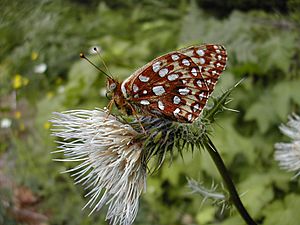Oregon silverspot facts for kids
Quick facts for kids Oregon silverspot |
|
|---|---|
 |
|
| Conservation status | |
| Scientific classification |
|
| Kingdom: | Animalia |
| Phylum: | Arthropoda |
| Class: | Insecta |
| Order: | Lepidoptera |
| Family: | Nymphalidae |
| Genus: | Speyeria |
| Species: |
S. zerene
|
| Subspecies: |
S. z. hippolyta
|
| Trinomial name | |
| Speyeria zerene hippolyta W. H. Edwards, 1879
|
|
The Oregon silverspot (scientific name: Speyeria zerene hippolyta) is a beautiful, but threatened butterfly. You can find it in parts of California and Oregon in the United States. It's a special type, or subspecies, of the Speyeria zerene butterfly.
Contents
Where the Oregon Silverspot Lives
The Oregon silverspot butterfly once lived along the coast from northern California, through Oregon, and into southern Washington. Sadly, it is now much rarer. Today, you can only find it in a few places in California and Oregon.
Some of the important places where these butterflies still live include:
- Cascade Head in Oregon
- Rock Creek Wilderness in Oregon
- Mount Hebo in Oregon
- Clatsop Plains in Oregon
- Lake Earl in California
Why the Butterfly is in Danger
In the state of Washington, the Oregon silverspot is listed as an endangered species. This means it is at high risk of disappearing forever. In fact, it is now thought to be completely gone from Washington.
California and Oregon do not have laws that protect insects like this butterfly. So, even though it is in danger, it doesn't have legal protection in those states. It is on a special list in California that helps keep track of rare animals.
The Oregon silverspot is closely related to two other butterfly subspecies found further south. These are Myrtle's silverspot (Speyeria zerene myrtleae) and Behren's silverspot (Speyeria zerene behrensii).
The Butterfly's Home and Food
Oregon silverspot butterflies need open, grassy areas near the coast to live. These areas used to stay open because of strong winds, ocean salt spray, and occasional wildfires. These conditions helped a special plant called the hookedspur violet (Viola adunca) grow. This violet is super important because it's the only plant the butterfly's caterpillars will eat!
In the past, wildfires helped keep the meadows open by clearing out bigger plants and trees. But now, with more people living in these areas, wildfires are stopped to protect homes. This means that forests are slowly growing over the open meadows where the butterflies and their food plant need to live.
Helping the Oregon Silverspot Survive
Scientists and conservation groups are working hard to save the Oregon silverspot. They are trying different ways to bring back and keep the open grassland habitat.
Restoring Habitats
One method they are testing is using controlled fires. These are small, carefully managed fires that help clear out unwanted plants, just like natural wildfires used to do. This helps the hookedspur violet grow better.
Raising Butterflies to Help Wild Populations
Since it takes a few years for the hookedspur violet plants to grow big enough, there's also a special project to help the butterflies right now. Teams from the Nature Conservancy, the U.S. Fish and Wildlife Service, Lewis & Clark College, and the Oregon Zoo work together.
They carefully collect female butterflies from the wild. These butterflies then lay eggs in special facilities at Lewis and Clark College and the Oregon Zoo in Portland. There's also a similar program at the Woodland Park Zoo in Seattle.
The young butterflies are raised in a safe environment. Once they reach the pupa stage (like a chrysalis), they are released back into the wild. This helps add more butterflies to the existing groups. For example, in 2016, nearly 450 silverspots were released at Mount Hebo. Experts believe that without this program, three out of the five remaining groups of Oregon silverspots might have already disappeared.


